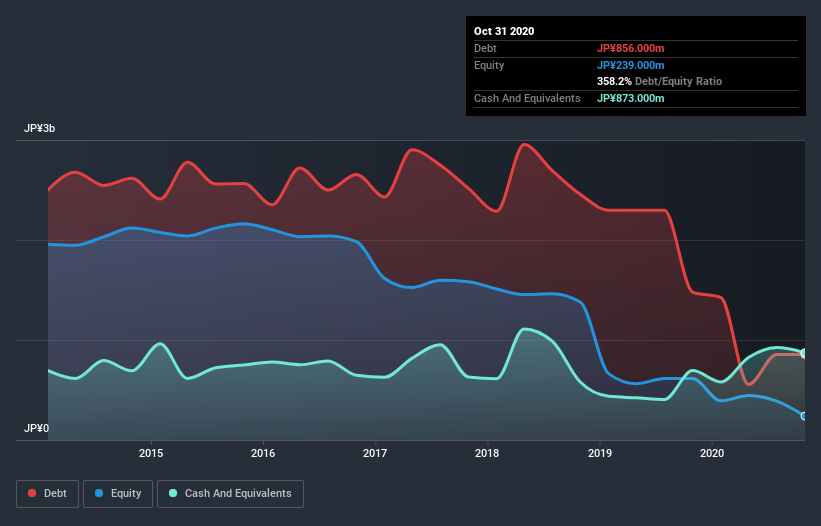The external fund manager backed by Berkshire Hathaway's Charlie Munger, Li Lu, makes no bones about it when he says 'The biggest investment risk is not the volatility of prices, but whether you will suffer a permanent loss of capital.' When we think about how risky a company is, we always like to look at its use of debt, since debt overload can lead to ruin. We can see that Amagasa Co., Ltd. (TYO:3070) does use debt in its business. But the real question is whether this debt is making the company risky.
When Is Debt A Problem?
Debt assists a business until the business has trouble paying it off, either with new capital or with free cash flow. In the worst case scenario, a company can go bankrupt if it cannot pay its creditors. However, a more common (but still painful) scenario is that it has to raise new equity capital at a low price, thus permanently diluting shareholders. Having said that, the most common situation is where a company manages its debt reasonably well - and to its own advantage. The first thing to do when considering how much debt a business uses is to look at its cash and debt together.
Check out our latest analysis for Amagasa
How Much Debt Does Amagasa Carry?
You can click the graphic below for the historical numbers, but it shows that Amagasa had JP¥818.0m of debt in October 2020, down from JP¥1.48b, one year before. But on the other hand it also has JP¥873.0m in cash, leading to a JP¥55.0m net cash position.

How Strong Is Amagasa's Balance Sheet?
The latest balance sheet data shows that Amagasa had liabilities of JP¥973.0m due within a year, and liabilities of JP¥461.0m falling due after that. Offsetting these obligations, it had cash of JP¥873.0m as well as receivables valued at JP¥345.0m due within 12 months. So its liabilities total JP¥216.0m more than the combination of its cash and short-term receivables.
Of course, Amagasa has a market capitalization of JP¥1.23b, so these liabilities are probably manageable. Having said that, it's clear that we should continue to monitor its balance sheet, lest it change for the worse. Despite its noteworthy liabilities, Amagasa boasts net cash, so it's fair to say it does not have a heavy debt load! The balance sheet is clearly the area to focus on when you are analysing debt. But you can't view debt in total isolation; since Amagasa will need earnings to service that debt. So if you're keen to discover more about its earnings, it might be worth checking out this graph of its long term earnings trend.
In the last year Amagasa had a loss before interest and tax, and actually shrunk its revenue by 41%, to JP¥2.9b. To be frank that doesn't bode well.
So How Risky Is Amagasa?
Statistically speaking companies that lose money are riskier than those that make money. And the fact is that over the last twelve months Amagasa lost money at the earnings before interest and tax (EBIT) line. Indeed, in that time it burnt through JP¥601m of cash and made a loss of JP¥787m. But the saving grace is the JP¥55.0m on the balance sheet. That kitty means the company can keep spending for growth for at least two years, at current rates. Summing up, we're a little skeptical of this one, as it seems fairly risky in the absence of free cashflow. When analysing debt levels, the balance sheet is the obvious place to start. But ultimately, every company can contain risks that exist outside of the balance sheet. To that end, you should learn about the 3 warning signs we've spotted with Amagasa (including 2 which are significant) .
If you're interested in investing in businesses that can grow profits without the burden of debt, then check out this free list of growing businesses that have net cash on the balance sheet.
If you’re looking to trade Amagasa, open an account with the lowest-cost* platform trusted by professionals, Interactive Brokers. Their clients from over 200 countries and territories trade stocks, options, futures, forex, bonds and funds worldwide from a single integrated account. Promoted
New: Manage All Your Stock Portfolios in One Place
We've created the ultimate portfolio companion for stock investors, and it's free.
• Connect an unlimited number of Portfolios and see your total in one currency
• Be alerted to new Warning Signs or Risks via email or mobile
• Track the Fair Value of your stocks
This article by Simply Wall St is general in nature. It does not constitute a recommendation to buy or sell any stock, and does not take account of your objectives, or your financial situation. We aim to bring you long-term focused analysis driven by fundamental data. Note that our analysis may not factor in the latest price-sensitive company announcements or qualitative material. Simply Wall St has no position in any stocks mentioned.
*Interactive Brokers Rated Lowest Cost Broker by StockBrokers.com Annual Online Review 2020
Have feedback on this article? Concerned about the content? Get in touch with us directly. Alternatively, email editorial-team (at) simplywallst.com.
About TSE:3070
JELLY BEANS GROUP
Plans, develops, wholesales, and retails non-leather women’s footwear in Japan.
Flawless balance sheet with low risk.
Market Insights
Community Narratives



